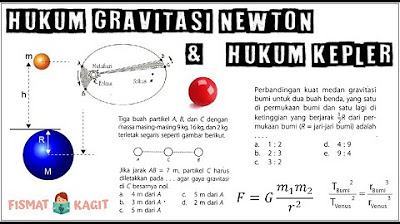Astrodynamics Fundamentals. Lesson-01
Summary
TLDRThis seminar introduces the fundamentals of gravity, deriving Kepler's laws from Newton's gravitational law. It explores the universal gravitational constant and planar motion, defining velocity and acceleration in both fixed and mobile frames. The script delves into angular momentum conservation, leading to the derivation of Kepler's laws, including the constant sweep speed of the celestial body's orbital area. It further explains the elliptical orbits with the sun as a focus, using the semilatus rectum and eccentricity to describe orbital parameters. The third law's connection between a planet's orbital period and the cube of its semi-major axis is also discussed.
Takeaways
- 📚 The seminar introduces the fundamental concepts of gravity, the equation of motion, and Kepler's laws.
- 🌌 Newton's law of universal gravitation is discussed, which states that the force between two masses is proportional to their product and inversely proportional to the square of the distance between them.
- 🔍 The gravitational force is vectorial and directed along the line connecting the two bodies, with the negative sign indicating an attractive force.
- 🌟 The universal gravitational constant (G) is given as 6.67 x 10^-11 m^3 kg^-1 s^-2.
- 📐 The script explains planar motion using a fixed frame (x, y, z) and a mobile frame (e1, e2, e3), defining velocity and acceleration in this context.
- 🔄 The angular velocity (omega) is introduced as normal to the motion plane, leading to expressions for velocity and acceleration.
- 🌐 Angular momentum (h) is shown to be constant for a system under the influence of a central force, leading to the derivation of Kepler's laws.
- 📉 Kepler's second law is derived, stating that a line segment joining a planet and the Sun sweeps out equal areas during equal intervals of time.
- 📘 The script derives Kepler's first law, which states that the orbits of planets are elliptical with the Sun at one focus.
- 🔢 The relationship between the semi-major axis (a), the eccentricity (e), and the semilatus rectum (p) is explored, leading to the formulation of the trajectory equation.
- ⏳ Kepler's third law is discussed, which relates the square of the orbital period to the cube of the semi-major axis of the orbit.
Q & A
What is Newton's law of gravitation, as explained in the seminar?
-Newton's law of gravitation states that the gravitational force between two bodies is proportional to the product of their masses and inversely proportional to the square of the distance between them. The force is directed along the line connecting the bodies and is attractive.
What is the significance of the gravitational constant (G) mentioned in the lecture?
-The gravitational constant (G) is a fundamental constant in Newton's law of gravitation. It has a value of 6.67 × 10^-11 cubic meter per kilogram per square second and helps quantify the gravitational force between two masses.
What is the velocity of a body in planar motion, as derived in the lecture?
-The velocity in planar motion is the derivative of the position vector with respect to time. It has two components: one along the radial direction (r) and one along the angular direction (theta), which can be derived using Poisson's theorem and angular velocity.
How is the angular momentum (h) related to the motion of a celestial body?
-The angular momentum (h) is the cross product of the position vector (r) and the velocity (v). It remains constant for celestial bodies in orbital motion because the gravitational force is always directed towards the central body.
What is the purpose of the Binet formulas in the context of orbital mechanics?
-The Binet formulas are used to express velocity and acceleration in terms of geometrical parameters like r (radius) and theta (angular position) without considering time. These formulas simplify the derivation of the laws governing orbital motion.
What is Kepler's second law, and how is it derived in the lecture?
-Kepler's second law states that a celestial body covers equal areas in equal time intervals as it orbits the Sun. This law is derived using the concept of angular momentum, which remains constant throughout the orbit.
What is the 'semilatus rectum' (p) in orbital mechanics?
-The semilatus rectum (p) is a parameter that represents the radius of a celestial body's orbit when the angular position theta is pi/2. It is a key term in describing elliptical orbits.
How is the first Kepler law demonstrated in the lecture?
-The first Kepler law, which states that planetary orbits are elliptical with the Sun at one focus, is demonstrated by solving a second-order linear differential equation for the orbital radius, using Binet formulas and initial conditions.
What does the third Kepler law describe, and how is it derived?
-The third Kepler law states that the square of the orbital period is proportional to the cube of the semi-major axis of the orbit. It is derived using the relationship between angular momentum, the orbital area, and the period.
What is the general form of the differential equation used to describe orbital motion?
-The differential equation for orbital motion is a second-order linear equation for 1/r, where r is the radial distance. This equation incorporates the gravitational constant and angular momentum and leads to solutions describing elliptical orbits.
Outlines

Cette section est réservée aux utilisateurs payants. Améliorez votre compte pour accéder à cette section.
Améliorer maintenantMindmap

Cette section est réservée aux utilisateurs payants. Améliorez votre compte pour accéder à cette section.
Améliorer maintenantKeywords

Cette section est réservée aux utilisateurs payants. Améliorez votre compte pour accéder à cette section.
Améliorer maintenantHighlights

Cette section est réservée aux utilisateurs payants. Améliorez votre compte pour accéder à cette section.
Améliorer maintenantTranscripts

Cette section est réservée aux utilisateurs payants. Améliorez votre compte pour accéder à cette section.
Améliorer maintenantVoir Plus de Vidéos Connexes
5.0 / 5 (0 votes)






